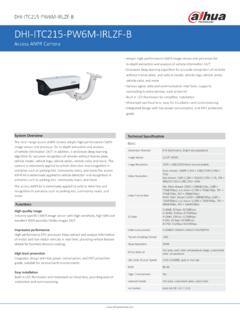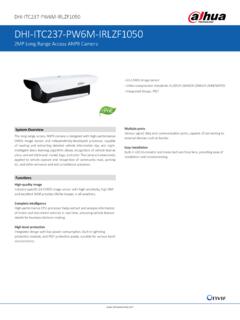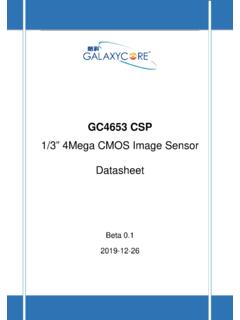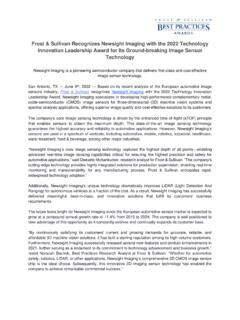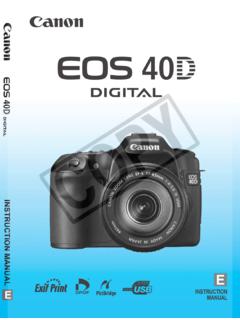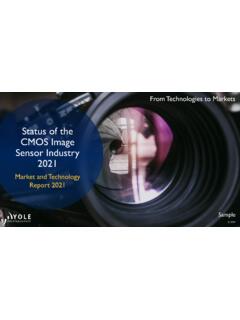Transcription of How a Charge Coupled Device (CCD) Image Sensor Works
1 How a Charge Coupled Device (CCD) Image Sensor Works50 YEARS of the CCDTELEDYNE IMAGING2 area defined by one of the pixels will be converted into one (or more) electrons and the number of electrons collected will be directly proportional to the intensity of the scene at each pixel. When the CCD is clocked out, the number of electrons in each pixel are measured and the scene can be reconstructed.(Above) Teledyne e2v CCD47-20 back- illuminated 1024 x 1024 pixel m pixel Boyle and George E. Smith invented the Charge - Coupled Device (CCD) in 1969 in the United States at AT&T Bell Labs. In 1970, Boyle and Smith submit-ted a paper on their invention of the CCD to the Bell System Technical Journal.
2 Their original ideas for the CCD was to create a memory Device . However, with the publication of Boyle and Smith s research in 1970, other scientists began experimenting with the technology on a range of appli-cations. Astronomers discovered that they could produce high-resolution images of distant objects, because CCDs offered a photosensitivity one hundred times greater than film. A Charge Coupled Device is a highly sen-sitive photon detector. The CCD is divided up into a large number of light-sensitive small areas (known as pixels) which can be used to build up an Image of the scene of interest. A photon of light which falls within How a Charge Coupled Device (CCD) Image Sensor Works3 HOW A Charge Coupled Device (CCD) Image Sensor WORKSTELEDYNE IMAGING4 COLLECTIOND uring integration, Charge is collected as clouds or buckets of electrons under biased electrodes.
3 At least two electrodes are required per pixel to control this Charge collection although typically four electrodes are used for scientific devices to optimise the peak signal. The Charge will collect in this region with a positive applied voltage. In practice, the Charge is stored in a buried channel region to keep it away from contact with the sur-face and one Image column is separated from the next with a channel stop. The structure shown is a single CCD pixel. Large numbers of pixels are combined to form imaging devices , for example the Teledyne e2v CCD290 has 81 million pixels. The diagram below shows a 3 x 3 array of electrodes or gates used to control the electrons within the CCD are made of polysilicon rather than metal as this is reasonably transparent to incoming light at wavelengths above about 400 nm and the fact that all pixels are identical and are read though a single output port gives a uniform most of the CCD, the electrodes in each pixel are arranged so that the Charge is transferred downwards along the columns.
4 Hence, during the CCD clocking operation, rows are transferred downwards to the final row (the readout register) which is used to transfer the Charge in each pixel out of the CCD so it can be measured. In the read out register, the electrodes are arranged so that the Charge is trans-ferred in the horizontal direction, along the readout register. When Charge has been collected and is to be read-out it is transferred one Charge packet at a time to an output amplifier 0 V10 V0 V0 VSection of a CCD ArraySubstrate Connection, SS 0V (ground)Stored ElectronsSubstrate (p-type) typically 600 m thickBuried Channel (n-type) about 1 m deepInsulator SiO2 about m thickElectrode or GateChannel-stopSection of a CCD Array with Electrodes and Channel Columns PolysiliconElectrodesChannel columns Substrate connection (SS)Incident photonsIncident photonsIncident photonsSignal generation by the photoelectric effect 0 V5 HOW A Charge Coupled Device (CCD)
5 Image Sensor Works where the Charge is converted to a voltage. During the readout operation, electrodes are alternately biased with high and low voltages to transfer Charge down the array. A single transfer step is shown below. For a 4 phase pixel 4 of these steps are required to transfer the Charge one pixel down the array. All of the electrodes in the Image area of a given phase are connected together so that only four clocks are needed to transfer the Charge down the Image area to a readout register. One row of Charge is transferred into the readout register at a time. The readout register is then clocked in the same way and read one pixel at a time at the output node by converting the Charge to a voltage.
6 In the figure below a 4 x 4 pixel three-phase Device is shown: Because the entire array is read through a single amplifier the output can be highly optimised to give very low noise and extremely high dynamic range. CCDs can have over 100dB dynamic range with less than 2e of noise. A CCD camera or instrument will consist of the CCD chip, and associated electronics, which is used at this point to amplify the small voltage on the CCD, remove noise components, digitise the pixel values and output the values of each pixel for example to a processor. The CCD is an analogue Device , and the analogue voltage values are converted into a digital form by the camera of Charge Transfer0 V+10 V0 V0 VStep 10 V+10 V+10 V0 VStep 20 V0 V+10 V0 VStep 3 Readout RegisterSingle pixelCharge-to-voltageOutput circuitOutputBias etcR 3R 2R 1I 1I 2I 3 Buried channelImage SectionElectrodesDetector MaterialCapabilitiesTeledyne Imaging s Sensor capabilities enable our Aerospace, Science and Defense partners to see farther, from X-ray to Very Long Wave m5 m10 m100 mHard X-RaySoft X-RayVacuum UVUVV isibleVisibleSWIRMWIRLWIRVLWIRS iliconInSbSubstrate-removed HgCdTe (MCT)
7 GermaniumInGaAsPbSePbSHgCdTe (MCT)InAsVOxInAs/GaSb (T2SL)SiAsTeledyne Imaging s Sensor Capabilities Span the Complete Spectrum from X-Ray to Very Long Wave are able to provide the right technology solution according to the application using a range of compound semiconductor materials taken from the imaging engineers periodic Image Sensor technologies range from CCD to CMOS through to hybrid infrared ROIC arrays and micro-bolometers, and A Charge Coupled Device (CCD) Image Sensor WORKSQUANTUM EFFICIENCYThe percentage of photons that are detected is known as the Quantum Efficiency (QE) of a detector. The human eye has a QE of approximately 20%, photographic film has a QE of around 10%, and modern day CCDs achieve a QE of over 90%.
8 Quantum efficiency varies with wavelength and can be extended across these wavelengths through innovations such as backthinning, back-illumination, anti-reflective coatings and high resistivity RANGECCDs can have a wide wavelength range ranging from about (soft x-ray) to 400 nm (blue visible) through to about 1000 nm (near infrared) with a peak sen-sitivity at around 700 nm. Detection in the shorter x-ray and ultraviolet wavelengths is made possible through back illumination and increased sensitivity in the longer near infrared wavelengths through lower noise and high resistivity silicon. DYNAMIC RANGEThe ability to view bright and faint sources correctly in the same Image is a very useful property of a detector.
9 The difference between a brightest possible source and the faintest possible source that the detector can accurately see in the same Image is known as the dynamic range. When light falls onto a CCD the photons are converted into electrons. The dynamic range of a CCD is usually discussed in terms of the minimum and maximum number of electrons that can be imaged. As more light falls onto the CCD, more and more electrons are collected in a potential well. Eventually no more electrons can be accommodated within the potential well and the pixel is saturated. For a typical scientific CCD this may occur at around 150,000 electrons or so. The minimum signal that can be detected is not necessarily one electron (correspond-ing to one photon at visible wavelengths).
10 In fact, there is a minimum amount of electronic noise which is associated with the physical structure of the CCD and is usually around 2 to 4 electrons for each pixel. Thus, the minimum signal that can be detected is determined by this readout noise. Single electron or Electron Multipli-cation CCDs (EMCCDs) are very low noise sensors designed to be highly sensitive detectors where very few photons or electrons are to be important consideration in a detector is its ability to respond linearly to any Image it views. If the CCD detects 100 photons it will convert these to 100 electrons (assuming 100% QE). In such a situation, the detector has a linear response.
